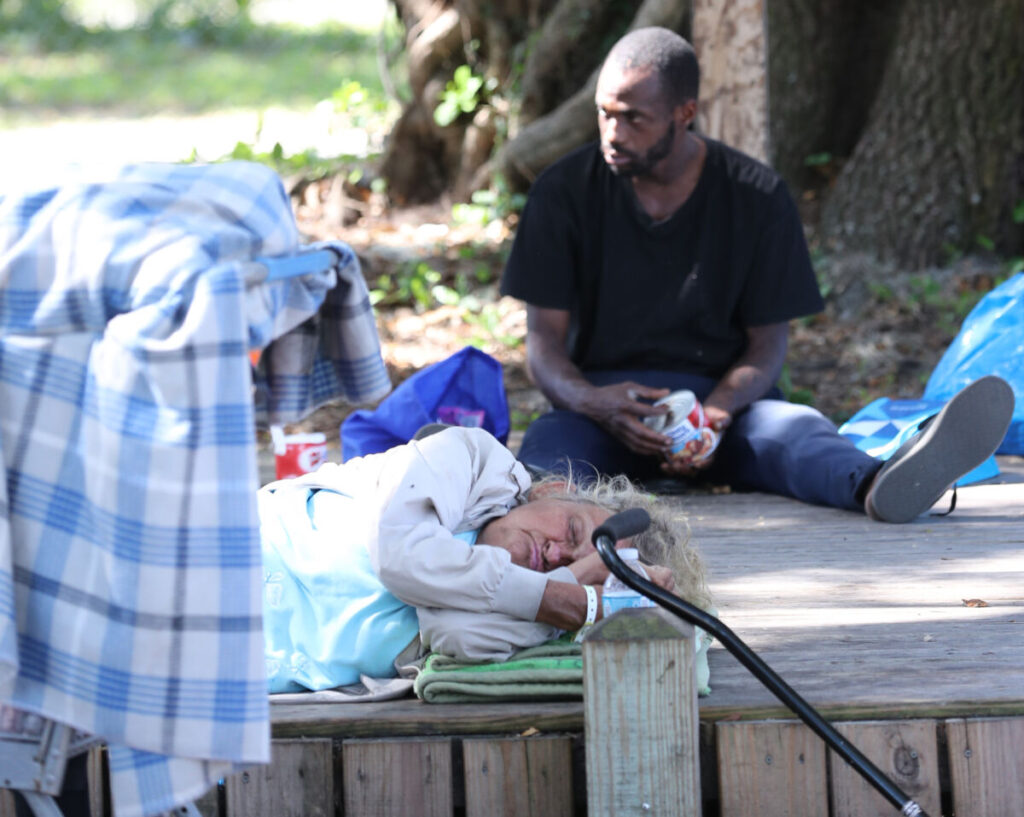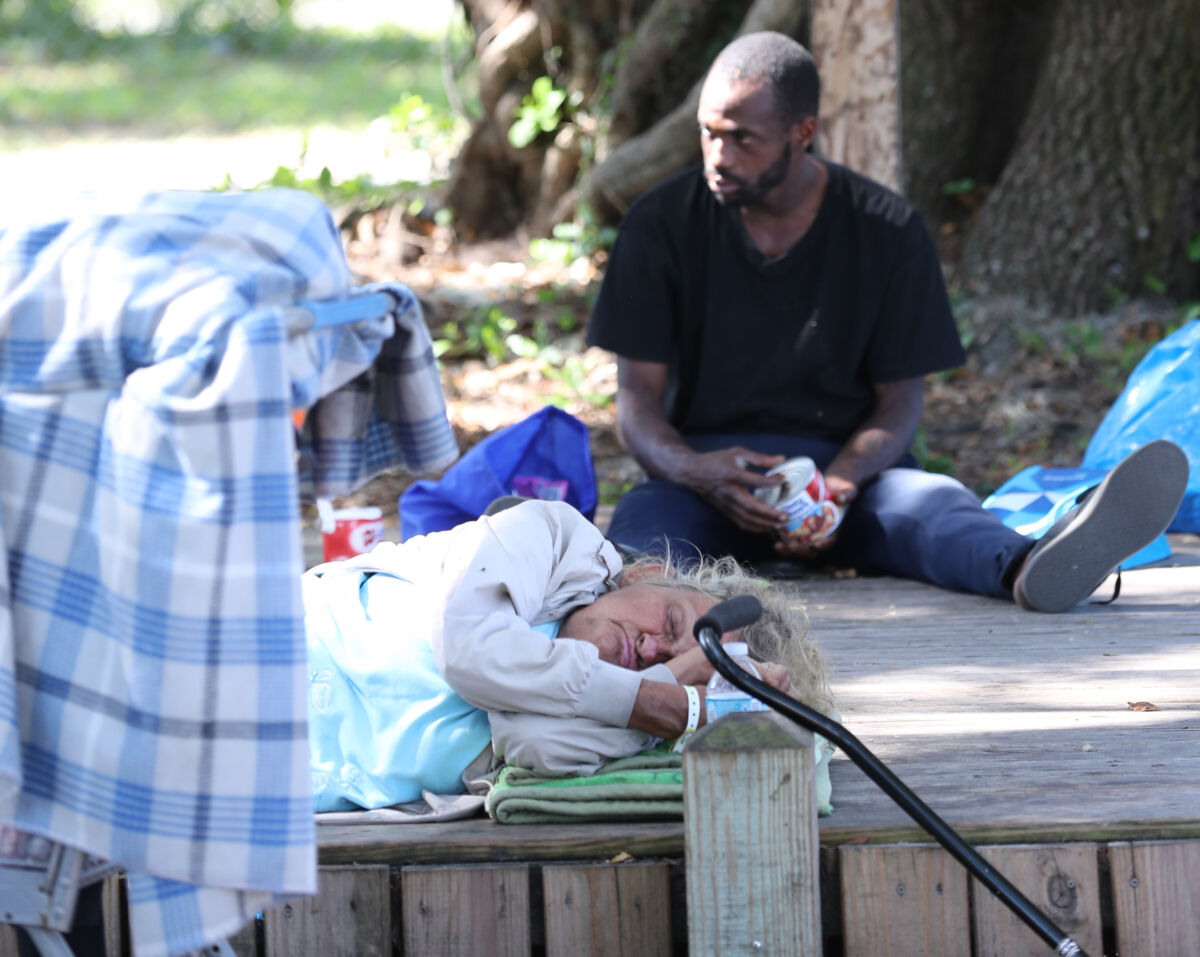Putting the Money Where the Problem Is

Homeless people sleep and rest in the Agape Garden at Interfaith Emergency Services on Northwest 2nd Street in Ocala, Fla. on Wednesday, May 5, 2021. [Bruce Ackerman/Ocala Gazette] 2021.

Homeless people sleep and rest in the Agape Garden at Interfaith Emergency Services on Northwest 2nd Street in Ocala on May 5. [Bruce Ackerman/Ocala Gazette]
We’ve all done it—daydreamed about what we would do if we won the lottery. Pay off the mortgage. Set up the kids’ college funds. Take that two-week vacation. Give money to your church or community organization. Buy that ridiculously fancy car.
With a large windfall of money, the spending options are many. This is something the Marion County Board of County Commissioners (MCBOCC) is realizing as they allocate the $71 million in funds provided to Marion County through the American Rescue Plan Act (ARPA), the $1.9 trillion package designed to aid local governments in response to the pandemic and its negative economic impacts.
This is our county’s version of winning the lottery. We have $71 million that could be used to alleviate the social problems plaguing our community, namely homelessness and substance abuse. Using even a quarter of that money would provide vital resources to our citizens who need it most.
Over the last year, Ocala’s homelessness issue has come to the forefront. Measures were taken by local government to shut down the open-air shelter at Interfaith Emergency Services while an “open lodging ordinance” directing the Ocala Police Department to arrest those found sleeping on the streets and in the doorways of area businesses was found unconstitutional by a higher court.
Laws and ordinances will not end the homeless problem in our community. We need financial assistance to better fund the non-profits in our area who are dedicated to serving this often overlooked population.
One of the eligible services of ARPA includes “building stronger neighborhoods and communities, including: supportive housing and other services for individuals experiencing homelessness, development of affordable housing, and housing vouchers and assistance relocating to neighborhoods with higher levels of economic opportunity.”
Throughout community discussions on the homeless issue, namely in the 2019 report by the Public Policy Institute of Marion County titled Homelessness: The Long Way Home, an engagement center/day center was strongly recommended as a way to provide the services the homeless population needs all in one central location.
Local shelters are “high barrier” shelters and do not allow people to congregate during the day. A day center/engagement facility could positively impact loitering and vagrancy activities among the homeless population. This facility would create a central access point to allow the homeless to obtain the services they need such as government assistance, mental health services, GED and ESOL classes and employment opportunities. This facility would ideally be located along bus routes to make it accessible to those lacking personal transportation.
The ultimate goal of this engagement/day center facility would be to ensure the needs of each individual are met and to guide them toward permanent housing.
Karla Grimsley Greenway, CEO of Interfaith Emergency Services, noted that a 4,500 square foot facility, which would include restrooms, showers, a laundry area, a kitchenette and two small meeting rooms, would cost approximately $855,000 to build. This does not include the purchase of the land on which the facility would be built.
Additionally, it would require two full-time staff members at $41,000 each for salaries, taxes and employment insurance. Utilities and liability insurance would run approximately $10,400. In total, it would cost roughly $92,400 to run this day center annually.
Using these relief funds to address dire social issues in communities is happening across the country. According to The Brookings Institution, cities nationwide are planning to use funds to alleviate the challenges facing low-income communities in their area.
For example, St. Louis has committed nearly $72 million to help their underserved communities by focusing on shelter and services for the homeless. Meanwhile, Boston, Minneapolis and Seattle have indicated their plans to designated Fiscal Recovery Funds (FRF) to address homelessness in their communities.
Over the last few decades, Ocala has worked tirelessly to push our cultural and economic sectors to the level of those big cities mentioned above. Utilizing some of these relief funds to address our homelessness issue would allow us to take care of our own while still maintaining our trajectory toward overall economic, cultural and social success.
The MCBOCC has the once-in-a-lifetime opportunity to make a long-term investment in these underserved individuals, and in turn, improve the spirit of our beloved Ocala.
To do so will mean we’ve all hit the jackpot.





